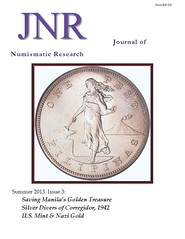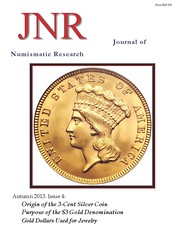
PREV ARTICLE
NEXT ARTICLE
FULL ISSUE
PREV FULL ISSUE
REVIEW: JOURNAL OF NUMISMATIC RESEARCH 3-5In December I reviewed the Spring 2013 (Issue 2) of Roger Burdette's excellent periodical, the Journal of Numismatic Research. I've fallen woefully behind in my reviews of all books this year, so in an attempt to play catch-up I'll highlight the three new issues Roger has generated in the interim. It's a stretch to call these "reviews", but hopefully I can add some color to the distributor's description. JNR Summer 2013, Issue 3
The Summer 2013 JNR is 62 pages devoted to valiant attempts by Filipino and American military and civilian personnel to prevent gold and silver from falling into the hands of the invading Japanese Army at the onset of World War II. This edition of the JNR includes the following three articles, all authored by Roger W. Burdette: Saving Philippine Gold at the Beginning of World War II
Following the surprise attack on Manila on December 8, 1942, banks and individuals sought to get their valuables, including gold bullion from local mines, to safety. One American submarine was able to help by using the gold and silver as ballast. The successful voyage of the "golden ship" USS Trout from Corregidor Island to Honolulu with its ballast crammed with gold, received considerable publicity on the American Homefront. Several popular articles appeared during and after the war that outlined the general events but omitted, or altered many details for war-time consumption. The article in this JNR presents the best modern research on the background, execution and conclusion of this amazing event. Copes of declassified relevant War Patrol Reports are included. Silver Divers of Corregidor
After all the gold and some of the Philippine silver was smuggled out on the Trout a large quantity of silver coins remained. Just before the Philippine island of Corregidor fell to the Japanese, these silver coins were dumped in Manila Bay. It was hoped that the coins could thus be hidden from the invaders. The Japanese soon learned the location and conscripted American Navy divers to bring the money to the surface. This fascinating story of bravery and determination was unknown during the war and received little public attention afterward. It was not until one of the divers, Robert C. Sheats, published his private memento of captivity, One Man's War: Diving as a Guest of the Emperor, that the story gained much-deserved attention. U.S.Mint & Nazi Gold, Merkers Kaiseroda Salt Mine
Treasure
This brief bonus feature reveals the U.S. Mint's role in recovering Nazi looted treasure following VE Day. Under orders from Nazi leadership, primarily Herman Goering and Heinrich Himmler, conquered people and nations were systematically stripped of art, gold and other valuables. Recovery of the treasure after the end of the European war had an unexpected connection to the U.S. Mint. I've already heard from other numismatists about how interesting and useful this issue is - never has so much information on the Philippine silver dump and recovery been compiled in one place. I'd read bits and pieces of the story in other publications, but this was a real page-turner, with interesting tidbits throughout. The related tale of the recovery of the Nazis' looted gold is another great story, particularly in light of the recent release of the film Monuments Men. The photo of a room filled with thousands of bags of gold is priceless. Highly recommended for anyone who enjoys the sweep of history and how its ebbs and flows directly affect people and their coinage. JNR Autumn 2013, Issue 4
This issue of the Journal of Numismatic Research features four short articles written by Roger W. Burdette. Origin of the 3-Cent Silver Coin --Beneath the angry public debates on slavery, new state admissions and regional commerce, two important topics permeated the country. One was the need for consistent national currency of gold and silver coins that was uniformly available and of equal value everywhere. The other was revision of the postal service so it could cheaply and securely ensure written communication across a vast, largely unpopulated continental nation. Out of these dual topics, emerged the nation's first 3-cent coin. Next comes a one page opinion piece James B. Longacre as a Die Engraver. Purpose of the $3 Gold Coin -- Coin collectors have long wondered why Congress approved introduction of a $3.00 gold coin in 1854. Numerous speculations have been put forward, but none identified the initial motivation for this odd, seemingly useless denomination. Learn the real reason for the $3 gold coin with this short article. Gold Dollars Used For Jewelry -- Necklaces, bracelets, cufflinks, rings, pendants and a multitude of other items of personal adornment became the final resting places of thousands of tiny gold dollars. Coin collectors were the only refuge for these forgotten gold pieces. This is an issue focused on two related "threes" - the three-cent silver coin and the three dollar gold piece. Roger reviews congressional legislation and contemporary news accounts to piece together the story of the origin of this tiny coin. Sen. Daniel Dickinson of New York introduced legislation in 1850 for new one and three cent coins to help replace fractional Spanish silver coins, which were still commonly used in circulation. In 1851 the adoption of the lower three-cent rate for postage also fueled the drive for the three-cent coin. Meanwhile, Roger's research indicates that contrary to statements found elsewhere in hobby publications, Congress did not link these coins to the new postage rates. In fact, these "purposeless curiosities" existed more as jewelry items than commercial specie, as did the diminutive one-dollar gold piece. The issue is rounded out by a short opinion piece which somewhat redeems James Longacre's reputation in other numismatic publications as an incompetent die sinker. While not exceptional, neither was Longacre a bumbling neophyte. JNR Winter 2014, Issue 5
This issue of the Journal of Numismatic Research, Winter 2014, examines the roles and relationships of female managers in Mint Bureau operations. Women had worked at the Philadelphia Mint since 1850, but it was not until 1875 that the first woman with professional qualifications was hired. Another generation passed before a woman, Margaret Kelly, was assigned to management responsibilities. Over the next thirty years Kelly and then Mary O’Reilly gradually expanded the management responsibilities of women until the first female director, Nellie Tayloe Ross, was appointed by President Roosevelt in 1933. Three interconnected articles reveal the social, technological and political changes that opened professional and managerial jobs to women, and explore forces that brought these three women into positions of authority over the nation’s coinage. As much as I've enjoyed all issues of JNR, this one is my favorite to date. Weighing in at a beefy 58 pages, this issue goes into depth about the women who have served as directors of the U.S. Mint. Not generally a topic covered in the numismatic press, this issue opens a window into the personalities and lives of these three pioneers. Also covered is Director Nellie Tayloe Ross' personal secretary Edness Wilkins, a heretofore unknown who nevertheless played an important role at the Mint, and was the only active coin collector among the staff at the time, collecting commemorative halves and U.S. Mint medals and speaking at her local coin clubs. All of the issues pass my back-of-the-book test, with extensive footnotes, endnotes and bibliographies. All are highly recommended. For more information, or to order, see:
To read the earlier E-Sylum article, see REVIEW: JOURNAL OF NUMISMATIC RESEARCH, SPRING 2013 (www.coinbooks.org/esylum_v16n52a06.html) Wayne Homren, Editor The Numismatic Bibliomania Society is a non-profit organization promoting numismatic literature. See our web site at coinbooks.org. To submit items for publication in The E-Sylum, write to the Editor at this address: whomren@gmail.com To subscribe go to: https://my.binhost.com/lists/listinfo/esylum All Rights Reserved. NBS Home Page Contact the NBS webmaster 
|


